Ziheng Jia
Image Quality Assessment: From Human to Machine Preference
Mar 13, 2025Abstract:Image Quality Assessment (IQA) based on human subjective preferences has undergone extensive research in the past decades. However, with the development of communication protocols, the visual data consumption volume of machines has gradually surpassed that of humans. For machines, the preference depends on downstream tasks such as segmentation and detection, rather than visual appeal. Considering the huge gap between human and machine visual systems, this paper proposes the topic: Image Quality Assessment for Machine Vision for the first time. Specifically, we (1) defined the subjective preferences of machines, including downstream tasks, test models, and evaluation metrics; (2) established the Machine Preference Database (MPD), which contains 2.25M fine-grained annotations and 30k reference/distorted image pair instances; (3) verified the performance of mainstream IQA algorithms on MPD. Experiments show that current IQA metrics are human-centric and cannot accurately characterize machine preferences. We sincerely hope that MPD can promote the evolution of IQA from human to machine preferences. Project page is on: https://github.com/lcysyzxdxc/MPD.
Information Density Principle for MLLM Benchmarks
Mar 13, 2025Abstract:With the emergence of Multimodal Large Language Models (MLLMs), hundreds of benchmarks have been developed to ensure the reliability of MLLMs in downstream tasks. However, the evaluation mechanism itself may not be reliable. For developers of MLLMs, questions remain about which benchmark to use and whether the test results meet their requirements. Therefore, we propose a critical principle of Information Density, which examines how much insight a benchmark can provide for the development of MLLMs. We characterize it from four key dimensions: (1) Fallacy, (2) Difficulty, (3) Redundancy, (4) Diversity. Through a comprehensive analysis of more than 10,000 samples, we measured the information density of 19 MLLM benchmarks. Experiments show that using the latest benchmarks in testing can provide more insight compared to previous ones, but there is still room for improvement in their information density. We hope this principle can promote the development and application of future MLLM benchmarks. Project page: https://github.com/lcysyzxdxc/bench4bench
Teaching LMMs for Image Quality Scoring and Interpreting
Mar 12, 2025Abstract:Image quality scoring and interpreting are two fundamental components of Image Quality Assessment (IQA). The former quantifies image quality, while the latter enables descriptive question answering about image quality. Traditionally, these two tasks have been addressed independently. However, from the perspective of the Human Visual System (HVS) and the Perception-Decision Integration Model, they are inherently interconnected: interpreting serves as the foundation for scoring, while scoring provides an abstract summary of interpreting. Thus, unifying these capabilities within a single model is both intuitive and logically coherent. In this paper, we propose Q-SiT (Quality Scoring and Interpreting joint Teaching), a unified framework that enables large multimodal models (LMMs) to learn both image quality scoring and interpreting simultaneously. We achieve this by transforming conventional IQA datasets into learnable question-answering datasets and incorporating human-annotated quality interpreting data for training. Furthermore, we introduce an efficient scoring & interpreting balance strategy, which first determines the optimal data mix ratio on lightweight LMMs and then maps this ratio to primary LMMs for fine-tuning adjustment. This strategy not only mitigates task interference and enhances cross-task knowledge transfer but also significantly reduces computational costs compared to direct optimization on full-scale LMMs. With this joint learning framework and corresponding training strategy, we develop Q-SiT, the first model capable of simultaneously performing image quality scoring and interpreting tasks, along with its lightweight variant, Q-SiT-mini. Experimental results demonstrate that Q-SiT achieves strong performance in both tasks with superior generalization IQA abilities.Project page at https://github.com/Q-Future/Q-SiT.
VQA$^2$:Visual Question Answering for Video Quality Assessment
Nov 06, 2024



Abstract:The advent and proliferation of large multi-modal models (LMMs) have introduced a new paradigm to video-related computer vision fields, including training and inference methods based on visual question answering (VQA). These methods enable models to handle multiple downstream tasks robustly. Video Quality Assessment (VQA), a classic field in low-level visual quality evaluation, originally focused on quantitative video quality scoring. However, driven by advances in LMMs, it is now evolving towards more comprehensive visual quality understanding tasks. Visual question answering has significantly improved low-level visual evaluation within the image domain recently. However, related work is almost nonexistent in the video domain, leaving substantial room for improvement. To address this gap, we introduce the VQA2 Instruction Dataset the first visual question answering instruction dataset entirely focuses on video quality assessment, and based on it, we propose the VQA2 series models The VQA2 Instruction Dataset consists of three stages and covers various video types, containing 157,735 instruction question-answer pairs, including both manually annotated and synthetic data. We conduct extensive experiments on both video quality scoring and video quality understanding tasks. Results demonstrate that the VQA2 series models achieve state-of-the-art (SOTA) performance in quality scoring tasks, and their performance in visual quality question answering surpasses the renowned GPT-4o. Additionally, our final model, the VQA2-Assistant, performs well across both scoring and question-answering tasks, validating its versatility.
AIM 2024 Challenge on Video Super-Resolution Quality Assessment: Methods and Results
Oct 05, 2024



Abstract:This paper presents the Video Super-Resolution (SR) Quality Assessment (QA) Challenge that was part of the Advances in Image Manipulation (AIM) workshop, held in conjunction with ECCV 2024. The task of this challenge was to develop an objective QA method for videos upscaled 2x and 4x by modern image- and video-SR algorithms. QA methods were evaluated by comparing their output with aggregate subjective scores collected from >150,000 pairwise votes obtained through crowd-sourced comparisons across 52 SR methods and 1124 upscaled videos. The goal was to advance the state-of-the-art in SR QA, which had proven to be a challenging problem with limited applicability of traditional QA methods. The challenge had 29 registered participants, and 5 teams had submitted their final results, all outperforming the current state-of-the-art. All data, including the private test subset, has been made publicly available on the challenge homepage at https://challenges.videoprocessing.ai/challenges/super-resolution-metrics-challenge.html
Q-Bench-Video: Benchmarking the Video Quality Understanding of LMMs
Sep 30, 2024



Abstract:With the rising interest in research on Large Multi-modal Models (LMMs) for video understanding, many studies have emphasized general video comprehension capabilities, neglecting the systematic exploration into video quality understanding. To address this oversight, we introduce Q-Bench-Video in this paper, a new benchmark specifically designed to evaluate LMMs' proficiency in discerning video quality. a) To ensure video source diversity, Q-Bench-Video encompasses videos from natural scenes, AI-generated Content (AIGC), and Computer Graphics (CG). b) Building on the traditional multiple-choice questions format with the Yes-or-No and What-How categories, we include Open-ended questions to better evaluate complex scenarios. Additionally, we incorporate the video pair quality comparison question to enhance comprehensiveness. c) Beyond the traditional Technical, Aesthetic, and Temporal distortions, we have expanded our evaluation aspects to include the dimension of AIGC distortions, which addresses the increasing demand for video generation. Finally, we collect a total of 2,378 question-answer pairs and test them on 12 open-source & 5 proprietary LMMs. Our findings indicate that while LMMs have a foundational understanding of video quality, their performance remains incomplete and imprecise, with a notable discrepancy compared to human performance. Through Q-Bench-Video, we seek to catalyze community interest, stimulate further research, and unlock the untapped potential of LMMs to close the gap in video quality understanding.
AIM 2024 Challenge on Compressed Video Quality Assessment: Methods and Results
Aug 21, 2024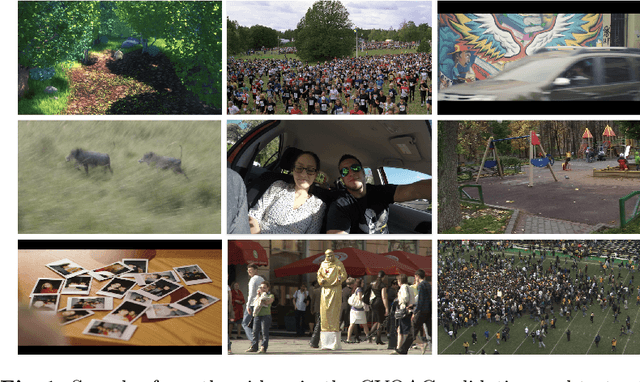

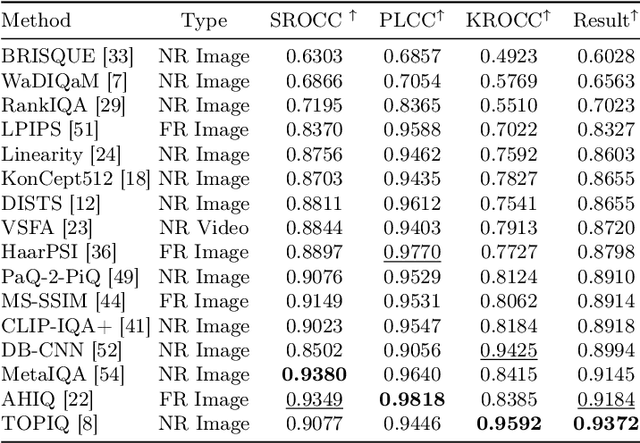
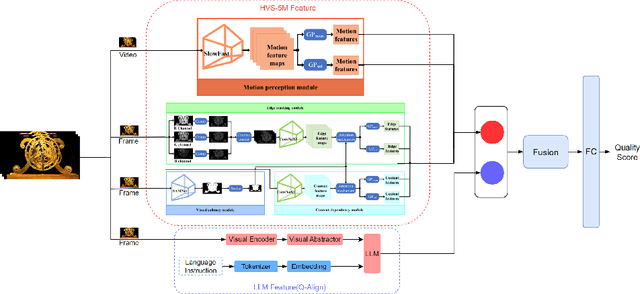
Abstract:Video quality assessment (VQA) is a crucial task in the development of video compression standards, as it directly impacts the viewer experience. This paper presents the results of the Compressed Video Quality Assessment challenge, held in conjunction with the Advances in Image Manipulation (AIM) workshop at ECCV 2024. The challenge aimed to evaluate the performance of VQA methods on a diverse dataset of 459 videos, encoded with 14 codecs of various compression standards (AVC/H.264, HEVC/H.265, AV1, and VVC/H.266) and containing a comprehensive collection of compression artifacts. To measure the methods performance, we employed traditional correlation coefficients between their predictions and subjective scores, which were collected via large-scale crowdsourced pairwise human comparisons. For training purposes, participants were provided with the Compressed Video Quality Assessment Dataset (CVQAD), a previously developed dataset of 1022 videos. Up to 30 participating teams registered for the challenge, while we report the results of 6 teams, which submitted valid final solutions and code for reproducing the results. Moreover, we calculated and present the performance of state-of-the-art VQA methods on the developed dataset, providing a comprehensive benchmark for future research. The dataset, results, and online leaderboard are publicly available at https://challenges.videoprocessing.ai/challenges/compressed-video-quality-assessment.html.
NTIRE 2023 Quality Assessment of Video Enhancement Challenge
Jul 19, 2023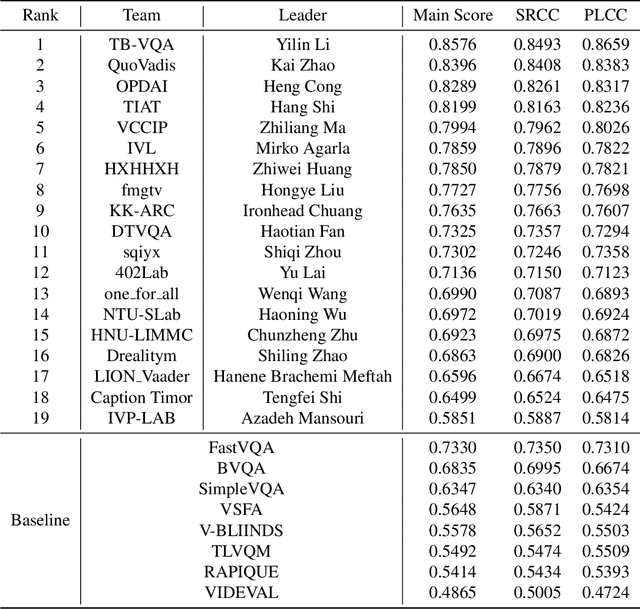
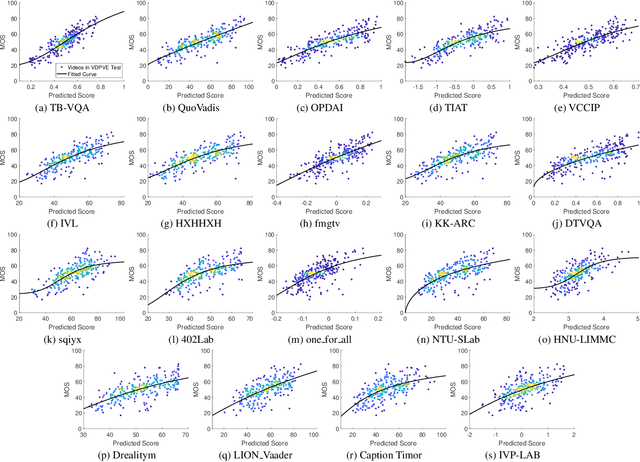


Abstract:This paper reports on the NTIRE 2023 Quality Assessment of Video Enhancement Challenge, which will be held in conjunction with the New Trends in Image Restoration and Enhancement Workshop (NTIRE) at CVPR 2023. This challenge is to address a major challenge in the field of video processing, namely, video quality assessment (VQA) for enhanced videos. The challenge uses the VQA Dataset for Perceptual Video Enhancement (VDPVE), which has a total of 1211 enhanced videos, including 600 videos with color, brightness, and contrast enhancements, 310 videos with deblurring, and 301 deshaked videos. The challenge has a total of 167 registered participants. 61 participating teams submitted their prediction results during the development phase, with a total of 3168 submissions. A total of 176 submissions were submitted by 37 participating teams during the final testing phase. Finally, 19 participating teams submitted their models and fact sheets, and detailed the methods they used. Some methods have achieved better results than baseline methods, and the winning methods have demonstrated superior prediction performance.
 Add to Chrome
Add to Chrome Add to Firefox
Add to Firefox Add to Edge
Add to Edge